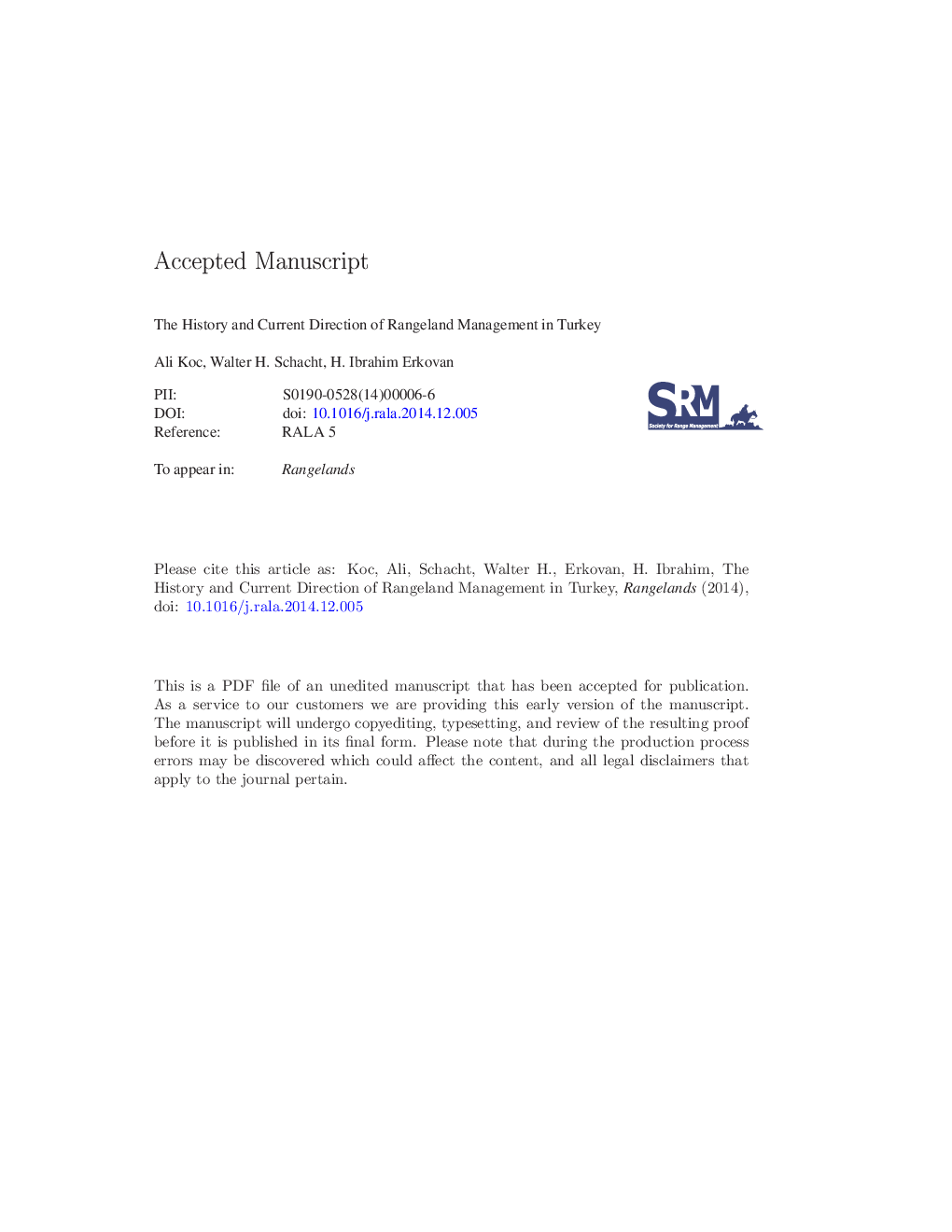| کد مقاله | کد نشریه | سال انتشار | مقاله انگلیسی | نسخه تمام متن |
|---|---|---|---|---|
| 4405249 | 1307225 | 2015 | 21 صفحه PDF | دانلود رایگان |
عنوان انگلیسی مقاله ISI
The History and Current Direction of Rangeland Management in Turkey
ترجمه فارسی عنوان
تاریخچه و کنونی مدیریت مرتع در ترکیه
دانلود مقاله + سفارش ترجمه
دانلود مقاله ISI انگلیسی
رایگان برای ایرانیان
کلمات کلیدی
بوقلمون، آناتولی، تراکسی دانش سنتی، پاره کردند، مرتع عمومی تخریب مراتع،
موضوعات مرتبط
علوم زیستی و بیوفناوری
علوم کشاورزی و بیولوژیک
علوم کشاورزی و بیولوژیک (عمومی)
چکیده انگلیسی
On the Ground
- Turkey is a country with many urban centers (Istanbul has 15 million people) and with a high gross national product (16th in the world). More than one-third of the country is rangeland and livestock production accounts for at least 30% of agricultural income.
- Rangelands and livestock production on rangelands historically have been at the center of Turkish society, economy, and culture. Roots of many Turkish range management practices can be traced back to the steppes culture of central Asia in 2500 BC.
- The government established strict policies and regulations on the communal rangelands allocated to each community by the central government. The grazing management regulations were based on strategies to ensure that 1) stocking rates did not exceed carrying capacity, 2) timing of grazing was in balance with seasonal conditions, and 3) grazing units were periodically deferred.
- The composition and productivity of Turkey's rangelands have degraded considerably since the early 1900s with an increasing density of humans and their livestock on grazing lands and an abandonment of the traditional policies and structure regulating grazing of rangelands.
- The Rangeland Act of 1998 gave the Turkish government authority to regulate the grazing season, carrying capacity, and rangeland development and use. Consideration of agrarian reform measures is at the center of revitalizing the publicly owned rangelands in Turkey.
- Turkey is a country with many urban centers (Istanbul has 15 million people) and with a high gross national product (16th in the world). More than one-third of the country is rangeland and livestock production accounts for at least 30% of agricultural income.
- Rangelands and livestock production on rangelands historically have been at the center of Turkish society, economy, and culture. Roots of many Turkish range management practices can be traced back to the steppes culture of central Asia in 2500 BC.
- The government established strict policies and regulations on the communal rangelands allocated to each community by the central government. The grazing management regulations were based on strategies to ensure that 1) stocking rates did not exceed carrying capacity, 2) timing of grazing was in balance with seasonal conditions, and 3) grazing units were periodically deferred.
- The composition and productivity of Turkey's rangelands have degraded considerably since the early 1900s with an increasing density of humans and their livestock on grazing lands and an abandonment of the traditional policies and structure regulating grazing of rangelands.
- The Rangeland Act of 1998 gave the Turkish government authority to regulate the grazing season, carrying capacity, and rangeland development and use. Consideration of agrarian reform measures is at the center of revitalizing the publicly owned rangelands in Turkey.
ناشر
Database: Elsevier - ScienceDirect (ساینس دایرکت)
Journal: Rangelands - Volume 37, Issue 1, February 2015, Pages 39-46
Journal: Rangelands - Volume 37, Issue 1, February 2015, Pages 39-46
نویسندگان
Ali Koc, Walter H. Schacht, H. Ibrahim Erkovan,
